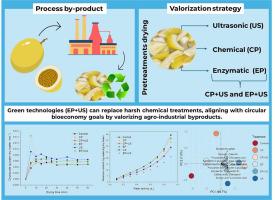综合超声、酶和化学预处理在西番莲果皮可持续增值过程中的强化
IF 3.9
3区 工程技术
Q3 ENERGY & FUELS
Chemical Engineering and Processing - Process Intensification
Pub Date : 2025-08-05
DOI:10.1016/j.cep.2025.110484
引用次数: 0
摘要
百香果加工过程中会产生残留物,其中果皮是主要的副产品。在本研究中,为了促进这些残留物的增值,对百香果皮进行了不同的预处理。这些方法包括超声波(US),化学(CP,使用碳酸钾)和酶(EP,使用Viscozyme®L)方法。在70°C对流干燥之前,分别进行预处理和联合预处理(CP+US和EP+US)。在干燥过程中,仅美国就减少了47.06%的干燥时间(270分钟,对照510分钟),增加了有效水分扩散率(7.28 × 10-9 m2/min)和对流系数(5.66 × 10-4 m/min) (p <;0.05)。CP+US和EP+US组合干燥时间比对照缩短了35.29% (330 min)。吸附等温线显示EP+US的吸湿性较低(Xm = 7.989 g H2O/g),表明EP+US在储存过程中提高了物理稳定性,减少了吸湿性。另一方面,CP (Tp = 70.02°C)和EP+US (ΔH = 2.39 J/g)的热稳定性较好,表明其具有较高的热降解性能。高效液相色谱法鉴定出19种酚类化合物,其中杨梅素(17.25 mg/100 g, CP+US)、儿茶素(7.36 mg/100 g)和果酸(10.12 mg/100 g)为重点化合物。180天后,EP+US保留了70.2%的酚类物质(最初为258.86 mg GAE/100 g,而ABTS为368.71 mg GAE/100 g),抗氧化剂损失较低(ABTS为26.7%)。主成分分析(PCA)和层次聚类分析(HCA)证实了联合预处理在生物活性提取中的有效性。最后得出结论:US、EP及其组合优化了干燥过程,有助于保存生物活性成分。在经过测试的策略中,EP+US被证明是最有希望用于工业应用的策略。此外,这种方法支持可持续的做法,从百香果加工副产品的价值。本文章由计算机程序翻译,如有差异,请以英文原文为准。

Integrated ultrasound, enzymatic, and chemical pretreatments for process intensification in the sustainable valorization of passion fruit peel
The processing of passion fruit generates residues, with the peels being the main by-product. In this study, to promote the valorization of these residues, passion fruit peels were subjected to different pretreatments. These included ultrasonic (US), chemical (CP, using potassium carbonate), and enzymatic (EP, using Viscozyme® L) methods. The pretreatments were applied individually and in combination (CP+US and EP+US), prior to convective drying at 70 °C. During the drying process, US alone reduced drying time by 47.06% (270 min vs. 510 min for the control), increasing effective moisture diffusivity (7.28 × 10–9 m2/min) and convective coefficient (5.66 × 10–4 m/min) (p < 0.05). The combinations CP+US and EP+US reduced drying time by 35.29% (330 min) compared to the control. The adsorption isotherm revealed lower hygroscopicity for EP+US (Xm = 7.989 g H2O/g), suggesting improved physical stability and reduced moisture absorption during storage. On the other hand, thermal properties indicated greater thermal stability for CP (Tp = 70.02 °C) and EP+US (ΔH = 2.39 J/g), suggesting higher resistance to thermal degradation. The bioactive compound profile by HPLC identified 19 phenolic compounds, with emphasis on myricetin (17.25 mg/100 g in CP+US), catechin (7.36 mg/100 g), and caftaric acid (10.12 mg/100 g). EP+US retained 70.2% of phenolics after 180 days (258.86 vs. 368.71 mg GAE/100 g initially), with lower antioxidant loss (26.7% in ABTS). Principal component analysis (PCA) and hierarchical cluster analysis (HCA) confirmed the effectiveness of the combined pretreatments in bioactive extraction. Finally, it is concluded that US, EP, and their combinations optimize the drying process and help preserve bioactive compounds. Among the tested strategies, EP+US proved to be the most promising for industrial applications. In addition, this approach supports sustainable practices for the valorization of by-products from passion fruit processing.
求助全文
通过发布文献求助,成功后即可免费获取论文全文。
去求助
来源期刊
CiteScore
7.80
自引率
9.30%
发文量
408
审稿时长
49 days
期刊介绍:
Chemical Engineering and Processing: Process Intensification is intended for practicing researchers in industry and academia, working in the field of Process Engineering and related to the subject of Process Intensification.Articles published in the Journal demonstrate how novel discoveries, developments and theories in the field of Process Engineering and in particular Process Intensification may be used for analysis and design of innovative equipment and processing methods with substantially improved sustainability, efficiency and environmental performance.

 求助内容:
求助内容: 应助结果提醒方式:
应助结果提醒方式:


